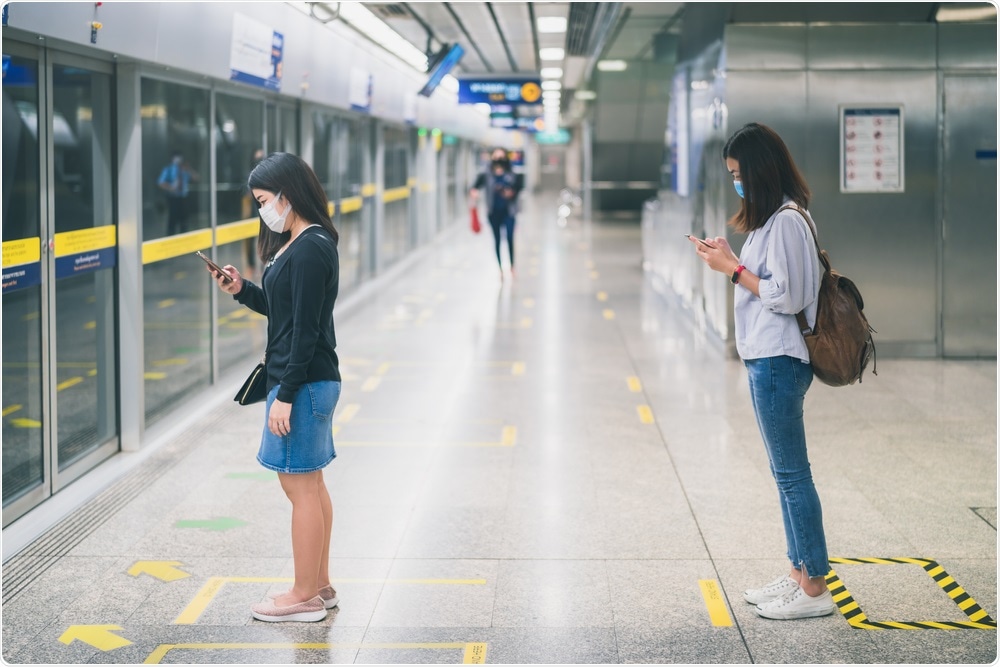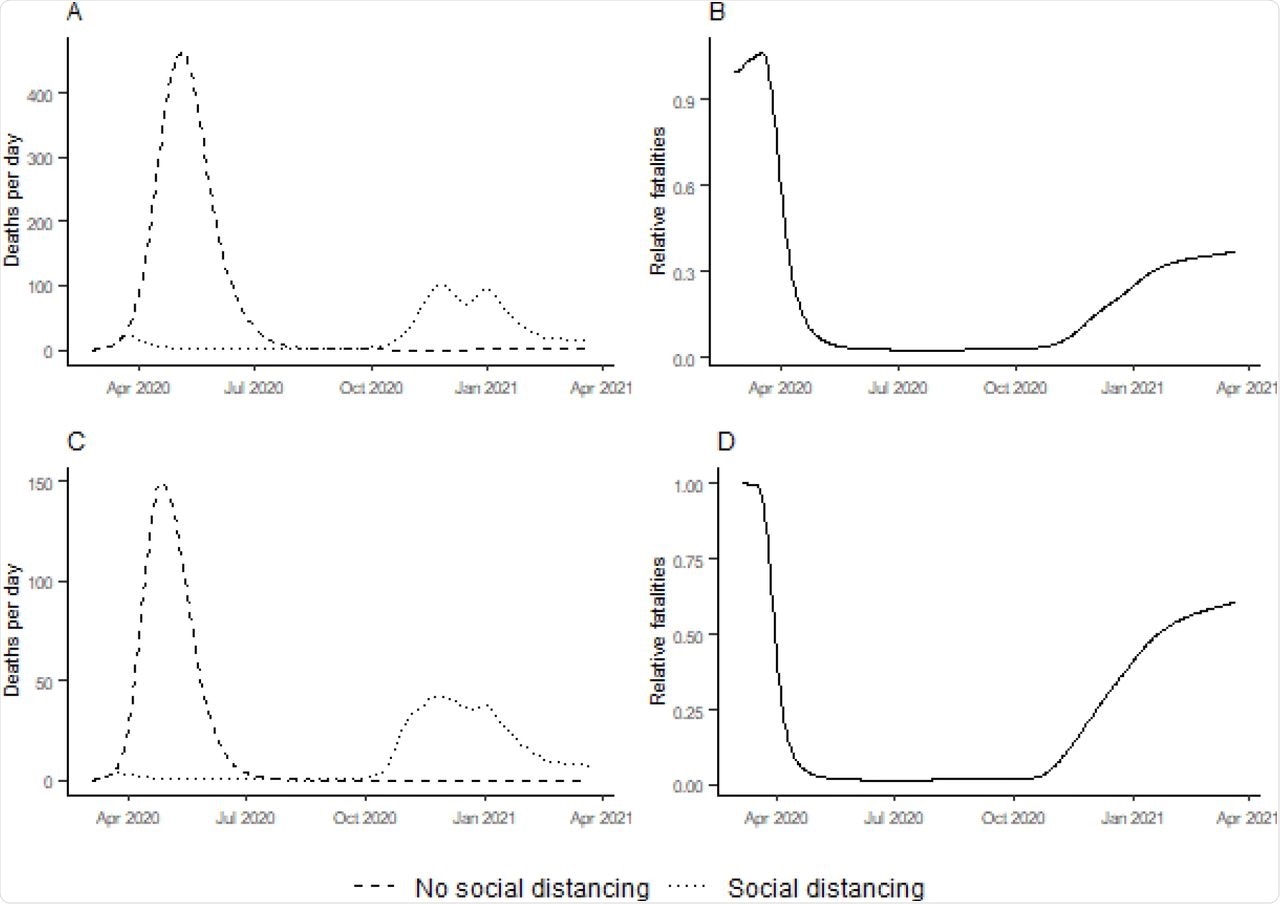The model demonstrated that although strict social distancing measures could significantly mitigate the initial severe acute respiratory syndrome coronavirus 2 (SARS-CoV-2) outbreaks during the spring of 2020, these measures unintentionally amplified the subsequent outbreaks during the winter of 2020-2021.

Study: Covid-19 social distancing: when less is more. Image Credit: Travel man / Shutterstock.com

 This news article was a review of a preliminary scientific report that had not undergone peer-review at the time of publication. Since its initial publication, the scientific report has now been peer reviewed and accepted for publication in a Scientific Journal. Links to the preliminary and peer-reviewed reports are available in the Sources section at the bottom of this article. View Sources
This news article was a review of a preliminary scientific report that had not undergone peer-review at the time of publication. Since its initial publication, the scientific report has now been peer reviewed and accepted for publication in a Scientific Journal. Links to the preliminary and peer-reviewed reports are available in the Sources section at the bottom of this article. View Sources
Background
As soon as the World Health Organization declared the COVID-19 outbreak a Public Health Emergency of International Concern in January 2020, most countries started imposing restrictions on public movement by closing schools and stores, banning large gatherings, restricting international travel, and limiting internal mobility. These measures aimed to reduce social contact and prevent epidemic peaks.
Several studies have confirmed that such social distancing measures reduced COVID-19-associated mortality and restricted the growth of pandemics. Nevertheless, these reports were based on data collected during the early stages of the pandemic, when social distancing measures were very stringent.
A previous study by the team suggested that if social distancing cannot be sustained over a sufficient length of time, such as the point of reaching herd immunity, a large second wave of outbreaks can nullify the mitigating effects of previously imposed restrictions. This theory implies that suppressing the outbreaks through social restrictions may preserve the epidemic potential. Furthermore, when such restrictions are lifted, the magnitude of the outbreaks that follow may be much higher.
Therefore, less stringent social distancing measures may, in some instances, yield better results than more stringent measures since less stringent social distancing can be maintained over more extended periods of time. Using Austria and Slovenia as examples, the team used a model-based systems analysis to investigate this hypothesis.
About the study
In the current study, a mathematical compartment model was calibrated against a one-year-long epidemiological timeline for Austria and Slovenia. The team simulated the real-time scenario with a hypothetical no-social-distancing scenario to investigate the impact of social distancing.
To evaluate the potential long-term benefits of less stringent social distancing measures, the team made another simulation comparing the true scenario with a hypothetical less stringent scenario during the early stages of the pandemic in the spring of 2020.
The basic reproduction number R0, which represents the number of cases generated by an infected person in a completely susceptible population, formed the most fundamental parameter in the model. The team assumed equal infectiousness for both symptomatic and asymptomatic carriers for modeling R0.
SARS-CoV-2 R0 may vary between a broad range due to differences in social habits, culture, and the methods used to estimate reproductive numbers. An R0 of 2.2 was assumed for the study based on the majority of reports.
The modifying effect of seasonality and social distancing on R0 was also considered. Reports on COVID-19 seasonality suggest a significant relationship between ultraviolet (UV) light and rates of COVID-19 spread. Therefore, the team also included the effects of UV radiation in the mathematical model.
To this end, the researchers recorded UV light intensities to estimate variations in seasonal transmissibility. To record the variations in the number of daily social contacts, the model utilized Google Mobility inputs.
Study findings
The current study involved the application of model-based systems analysis to investigate the effectiveness of social distancing measures in the mitigation of COVID-19. The calibrated compartment model closely reproduced the trajectories of confirmed daily and cumulative deaths in Slovenia and Austria.
Upon comparing the results with national records, the model suggested that 75% of infections in Austria and 82% of infections in Slovenia were undocumented. Likewise, other model-based studies have also estimated similarly high levels of undocumented infections in other countries, including France, Italy, Spain, China, and the United States.
The analysis indicated that although contact reduction drastically curtailed infections and fatalities during the early stages of the pandemic, these benefits tend to be lost over the long term, as demonstrated from U-shaped relative fatality curves derived from the model. Mortalities in the model with a social distancing scenario gradually approximated mortalities in scenarios without any social contact reduction.
“Total eradication and prolonged containment strategies have only proved epidemiologically successful in the long-term for few countries, some of which are characterized by consistently high solar irradiation and negligible seasonality (e.g. Singapore), or by geographic isolation (e.g. New Zealand).”
The team suggests that a decline in the effectiveness of social distancing could be a result of initial stringent containment and the presence of a large pool of susceptible individuals that coincided with elevated transmissibility in the fall and winter months. A previous sensitivity analysis showed that an increase in the basic reproduction number R0 further weakens the effectiveness of social distancing, which is highly relevant given the presumed gains in transmissibility of newly emerging variant strains of SARS-CoV-2.
Based on model simulations, the team suggests that social distancing is more effective in low R0 situations and less in high R0. Applications of social distancing in high R0 situations resulted in multiple waves of outbreaks and U-shaped relative fatality curves, thus demonstrating that benefits are lost in the long term. Comparatively, the low R0 situations resulted in single outbreaks and L-shaped relative fatality curves.

Comparison of simulated outbreaks with and without social distancing in Austria (A, B) and Slovenia (C, D). A and C: simulated outbreaks with social distancing (calibrated against recorded data) and simulated outbreaks with no social distancing. B and D: relative fatalities, i.e. ratio of the number of fatalities in social distancing scenarios to those in no-social-distancing scenarios.
Conclusions
The team demonstrated that less stringent social distancing measures mitigated high potential winter outbreaks using Austria and Slovenia as examples, which reduced the overall number of infections. The modeled scenarios showed that if social interactions were greatly increased, the resulting effects were strong enough to reduce the cumulative fatality numbers to below the recorded fatality numbers.
“In view of these preconditions and the expected ineradicable nature of the pathogen, easing social-distancing during low-transmission seasons in order to relieve pressure from high-transmission seasons was found to mitigate large winter outbreaks.”

 This news article was a review of a preliminary scientific report that had not undergone peer-review at the time of publication. Since its initial publication, the scientific report has now been peer reviewed and accepted for publication in a Scientific Journal. Links to the preliminary and peer-reviewed reports are available in the Sources section at the bottom of this article. View Sources
This news article was a review of a preliminary scientific report that had not undergone peer-review at the time of publication. Since its initial publication, the scientific report has now been peer reviewed and accepted for publication in a Scientific Journal. Links to the preliminary and peer-reviewed reports are available in the Sources section at the bottom of this article. View Sources